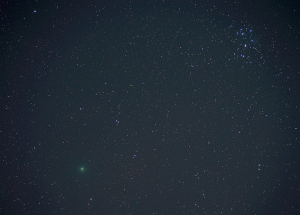“The Christmas Comet” is in Taurus and likely as close as it’ll be to Earth for at least another 20 years. The best night to view the comet was Saturday (12/16) where it achieved the closest point of it’s pass at about 7.1 million miles over Tranquility Base. We were at a neighborhood Christmas parade and party that night and it’s been overcast since. Last night looked to be the next available window, so I blew the dust off my brain and set up to hopefully take a photo. Well, if there is one consistency in this hobby, it is that challenges arise. There was tremendous (albeit beautiful) spotty cloud coverage for the first several hours after sunset… but that wasn’t the rub. The moon was SO bright that polar alignment was tricky and imaging in full band was going to be a problem. My goal from the start was to try to get the comet and M45 in the same frame, so I pressed on with what I’d already set up and crossed my fingers. It was quickly clear to me that I wasn’t going to pull off anything close to my attempt at C/2011 W3 (Lovejoy) in 2015, so I decided to try something completely new to me… an animated image. So yes, there is not much to speak of in terms of capturing a magnificent coma or nebulosity around Pleiades, but you do get three hours of the comet’s journey through our solar system… from 9pm to midnight last night. Cheers!
Comet 46P/Wirtanen is a small short-period comet with a current orbital period of 5.4 years… meaning it swings on by us every five and a half years. It belongs to the Jupiter family of comets, all of which have aphelia between 5 and 6 AU. Short period means it’s orbit is less than 20 years and “Jupiter family” is just saying that it’s orbit is dictated/controlled by Jupiter’s gravitational field (aphelia is the maximum distance it gets from it’s controlling body). Its diameter is estimated at 1.2 kilometers, so almost three-quarters of a mile at it’s widest bits. 46P/Wirtanen was discovered photographically on January 17, 1948, by the American astronomer Carl A. Wirtanen. The plate was exposed on January 15 during a stellar proper motion survey for the Lick Observatory. Due to a limited number of initial observations, it took more than a year to recognize this object as a short-period comet. You can still see it if you have any interest as it is quite bright at the moment. If you are near any form of light pollution, you’ll probably need some binoculars to find the feint fuzzy traveling 83,000 mph overhead.

